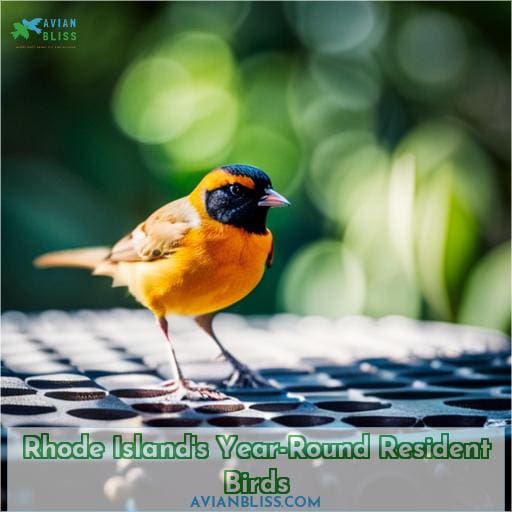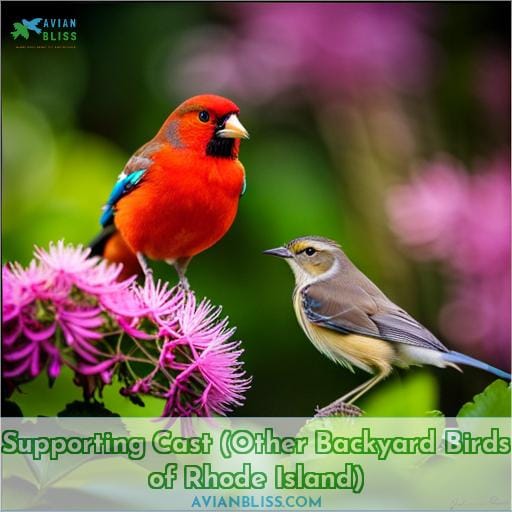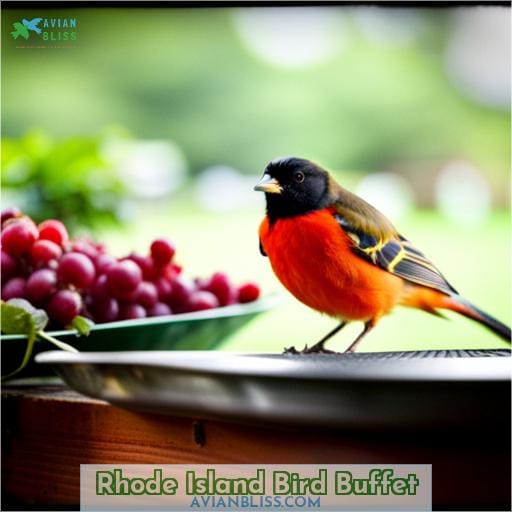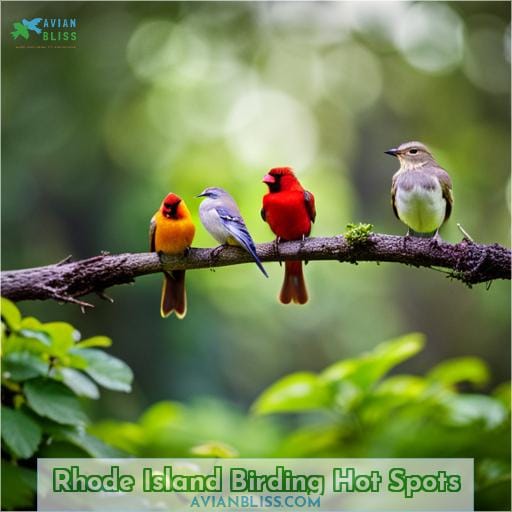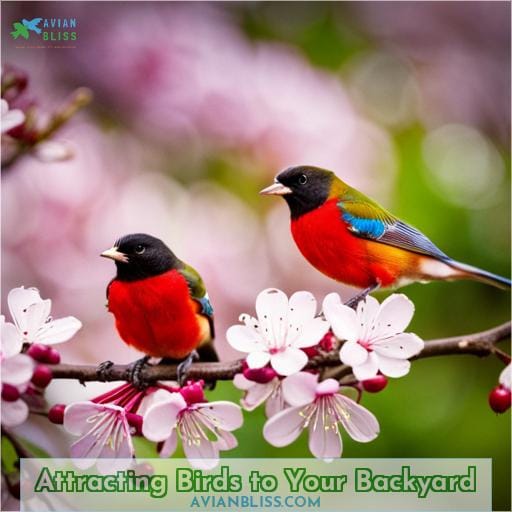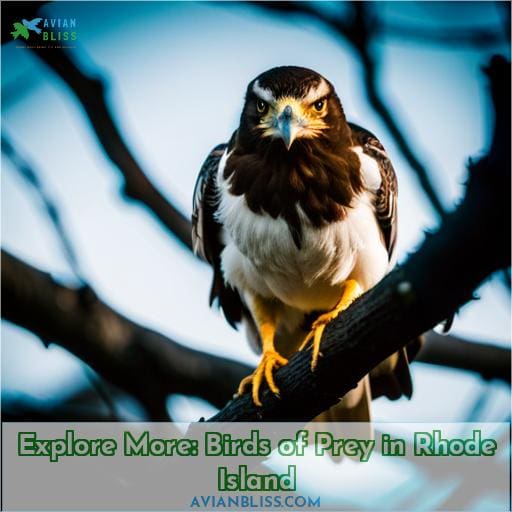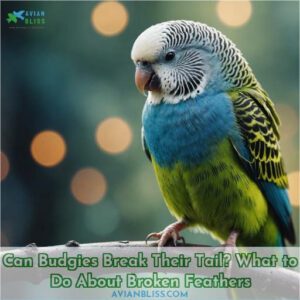This site is supported by our readers. We may earn a commission, at no cost to you, if you purchase through links.
 You’ve got quite the aviary outside your window! With over 400 species recorded, Rhode Island is a bird watcher’s paradise. Let’s take a peek at the colorful cast that flock to backyards like yours. We’ll get better acquainted with your feathered friends, explore what draws them in, and make your yard the hot spot on their migration route.
You’ve got quite the aviary outside your window! With over 400 species recorded, Rhode Island is a bird watcher’s paradise. Let’s take a peek at the colorful cast that flock to backyards like yours. We’ll get better acquainted with your feathered friends, explore what draws them in, and make your yard the hot spot on their migration route.
Roll out the welcome mat, and they’ll thank you in song. Chickadees, sparrows, woodpeckers—they’re all just a well-stocked feeder away.
Table Of Contents
- Key Takeaways
- Rhode Island’s Year-Round Resident Birds
- Rhode Island’s Birds of Spring, Summer, and Early Fall
- Rhode Island’s Fall and Winter Birds
- Supporting Cast (Other Backyard Birds of Rhode Island)
- Rhode Island Bird Buffet
- Rhode Island Birding Hot Spots
- Attracting Birds to Your Backyard
- Birding Etiquette and Ethics
- Explore More: Birds of Prey in Rhode Island
- Conclusion
Key Takeaways
- Rhode Island is home to over 400 bird species.
- There are several year-round resident birds with distinctive features and calls, such as the Northern Cardinal with its bright red plumage and the Tufted Titmouse with its recognizable peter-peter song.
- Some birds breed in Rhode Island during the summer, like the Scarlet Tanager and the Eastern Towhee, while others migrate south for the warmer winter months.
- Certain species have unique characteristics, from the brilliant orange and black colors of the Baltimore Oriole to the familiar cheer cheer cheer of the Carolina Chickadee.
Rhode Island’s Year-Round Resident Birds
Seeing our feathered friends outside the windows or hopping around the yard fills us with delight. American robins forage on lawns, American goldfinches cling to thistle feeders, gray catbirds mew from shrubbery, northern cardinals sing their whistles, and song sparrows trill their upbeat tunes as we take in the easy entertainment of our backyard residents.
American Robin
With its recognizable reddish-orange breast, you’ll spot the ubiquitous American Robin among Rhode Island’s diverse year-round avian residents. This thrush is a welcome sight at backyard feeders, lawns, and parks. Watch for its tilted run and listen for its cheerful caroling as it hops along the ground in search of earthworms and insects.
The American robin builds an open cup nest of mud and grass, often returning to the same site annually.
American Goldfinch
You’ll love seeing these bright yellow, black-capped strict vegetarians bouncing around your feeders. The American Goldfinch has a melodious warble and breeds in late summer when thistles provide nesting materials.
A late nester, this true harbinger of the seasons waits until thistle has ripened to raise families. Its undulating flight and nasal po-ta-to-chip calls bring joy. Thistle seeds and nyjer are goldfinch favorites; they’ll breed, winter, and spring in Rhode Island’s meadows and yards.
Gray Catbird
Hear the cat-like meows of the dark gray Gray Catbird as it skulks through dense thickets in your yard. This secretive mimic with a slate gray body and black cap prefers shrubbery and vines.
- Sings a varied repertoire of songs, including mimicking other birds.
- Nests in dense shrubs or small trees, weaving a bulky nest of twigs.
- Migrates south for the winter, returning to breed in spring.
- Attract with fruiting shrubs like elderberry and dogwood.
The meowing call often gives away the presence of the elusive Gray Catbird.
Northern Cardinal
Spot the striking red bird with a black mask and crest feasting at your feeders. Its brilliant plumage and whistling song are delightful as you observe the northern cardinal. This backyard beauty favors shrubs and thickets, building cup nests in dense foliage.
Feeders stocked with sunflower seeds attract cardinals all year, as they primarily eat seeds and fruit. Keep brush piles that provide nesting spots for this wary yet acclimating bird. Watch territories marked and pairs bond amid winter’s bare trees before the nesting season arrives.
Savor their presence as cardinals grace snowy yards, an iconic symbol of the season.
Song Sparrow
Envision the streaky brown Song Sparrow belting out its recognizable melody as you stroll through the brush. Dense thickets and tangled vines weave an intricate web – a sparrow’s paradise. Search for nests hidden in low branches while listening for song variations. Mimic its simple, repetitive tune and wait for a response.
With patience, you may glimpse these skittish birds hopping through leaf litter, foraging for seeds amidst briars. Though easily obscured, the Song Sparrow’s cheerful song resonates, beckoning you to explore its domain.
Rhode Island’s Birds of Spring, Summer, and Early Fall
The forked tail and reddish-orange underbelly of the Barn Swallow make this aerial insectivore a familiar sight from spring through early fall in Rhode Island. You may also spot the brilliant blue plumage of the Blue Jay, the rosy-red throat of the House Finch, the rusty black markings on the Rusty Blackbird, and the olive-brown coloration with yellow eyebrow stripes of the Palm Warbler as spring and summer transition to early autumn in the Ocean State.
Barn Swallow
That soaring barn swallow skimming the pond’s blue surface is sure to catch your eye!
- Nesting under eaves and bridges, building mud nests
- Returning from South America in March and April
- Expertly snatching insects midair as an aerial insectivore
- Preferring open areas near water for foraging
- Maintaining stable populations that make it a species of least concern
Feel yourself pause to delight in spotting this beautiful harbinger of spring.
Blue Jay
You’d be impressed by a Blue Jay’s vibrant sapphire plumage against a bright summer sky. Blue Jays compete vigorously for dominance with raucous ‘jay-jay’ calls. Their cleverness allows them to stash acorns for winter while alarming other birds with convincing imitations of hawks.
Jays prefer suet, peanuts, and sunflower seeds at backyard feeders. Highly social, flocks of jays bathe together in birdbaths before gathering more provisions for their families. With bright blue feathers and a boisterous attitude, Blue Jays bring excitement to backyards.
House Finch
You’ve spotted the rosy-red throat of a male House Finch perched in your backyard. Fond of sunflower seeds, nyjer seeds, and suet, he visits feeders frequently with his drab brown female and offspring.
Aggressive at feeders against other songbirds like sparrows, his melodious warbling song rings out as breeding season arrives. Sporting vibrant raspberry plumage, the male woos his mate, who then constructs an artful nest of twigs, grasses, and pet hair.
Though populations declined due to disease, they have rebounded across the eastern US.
Rusty Blackbird
I haven’t yet seen a Rusty Blackbird’s rusty markings in winter, but you’ll spot them in muddy swamps foraging for insects before migrating north. They flap to northerly breeding grounds after spending winters down south. Their rust-colored plumage blends into flooded woods and swamplands.
Watch for these sociable blackbirds mingling in flocks among reeds and cattails. Observe them wading in shallows, probing mud for aquatic insects. Rusties are a species of concern, needing wetland conservation for their at-risk population.
Protecting their habitat may reward you with a visit from these iconic harbingers of spring.
Palm Warbler
You glimpse the olive-brown Palm Warbler flitting through low bushes, recognizing its distinctive yellow eyebrow lines. During migration, this nervous forager supplements its diet with insects by flicking its tail up and down.
The male’s spring plumage shows rusty cap feathers while the female’s remains olive-yellow. The Palm Warbler nests on the ground in open coniferous forests across Canada and Alaska where it migrates 3,000 miles to winter in the Southeastern U.
S. It prefers foraging on seeds on forest floors but will visit platform feeders for millet and sunflower hearts.
Rhode Island’s Fall and Winter Birds
As the leaves dissolve into scattered copper, brown, and gold, the passing of autumn brings new birds to your backyard in Rhode Island. Juncos dart beneath bushes and trill their musical songs as ponderous nuthatches rummage nose-first down trunks, practically upside down, whites and browns blending entirely into the snowy landscape.
Dark-eyed Junco
These slate-colored birds with white bellies flock here when the weather turns cold. The dark-eyed junco is one of the most common winter backyard birds in Rhode Island. Adaptable and hardy, juncos thrive in our cold winters. They sport different plumages based on age and location, but all have the telltale dark hood and pinkish bill.
Juncos forage in flocks, feeding readily at ground-feeding stations on a variety of seeds. Though they retreat northward come spring, juncos are a reliable presence through our coldest months.
Tufted Titmouse
Those iconic gray-blue tufted titmice with their cute topknots are regulars at Rhode Island feeders when temperatures drop. They are acrobatic birds that actively forage foliage, clinging upside down to snag insects.
Preferring dense woods with brushy understory, they frequent backyards with shrubs. Seeds and suet are welcomed during winter. Their Peter Peter calls echo through the leafless trees as breeding season begins.
Look for titmice fluttering between branches and chasing each other playfully while filling up on sunflower seeds from your feeders.
White-throated Sparrow
Having molted their distinctive zebra-striped skunk cap, white-throated sparrows still provide a cheerful whistle while foraging on the ground for seeds throughout Rhode Island’s frosty winter days. Hopping along with constant tail-wagging, these large-beaked sparrows probe leaf litter with sideways thrusts of their bill, scattering debris seeking seeds and insects.
White-striped juveniles join gray-striped adults at backyard feeders; both sing their distinctive oh sweet Canada Canada Canada whistle. Though they breed in Canada, white-throats overwinter across most of eastern North America.
Numerous in Rhode Island, their whistling and enthusiastic foraging brighten winter days.
It seems like you’ve provided a detailed article about various bird species in Rhode Island. If you have any specific questions about these birds or need more information on a particular species, feel free to ask.
Red-breasted Nuthatch
You’ll adore the endearing blue-gray Red-breasted Nuthatch in your feeders this season. Active and acrobatic, this agile climber sidles up and down tree trunks searching for hidden seeds and insects. Their nasal yank-yank calls reveal busy nuthatches nearby. Offer sunflower seeds, suet and peanuts to attract these charismatic birds now being spotted more frequently in Rhode Island as their typical northern habitat grows colder.
With luck, a pair may nest in your backyard nest box come spring, so have one ready for these cavity-nesting beauties.
Snow Bunting
Disguised in spring’s white dress, snow buntings shed their brilliant plumage when nesting in the Arctic. Believe it or not, these birds’ breeding plumage is actually mostly snow white! Come fall, stark black wing and body markings emerge, perfect for blending into the tundra’s rocky, snow-patched terrain.
Flocks descend on northern states in search of seeds, singing soft calls that belie their hardy resilience. Spot these winter visitors perching atop fences or flitting between snow banks, adding a touch of the north to Rhode Island’s wintery days.
Supporting Cast (Other Backyard Birds of Rhode Island)
While out birdwatching in your Rhode Island backyard, you’ll likely spot a supporting cast of resident birds as well. The Black-capped Chickadee flits about the feeder with its gray body, black cap, and bib, while the iridescent European Starling forages on the ground.
The White-breasted Nuthatch hitches down tree trunks, the Mourning Dove moans, and the House Sparrow chirps away.
Black-capped Chickadee
Dainty chickadees with black caps brighten the arbor while pecking at seed.
- Endearing sprites that flit to feeders
- Cavity nesters who excavate tree holes
- Hardy survivors of bitter northeast winters
Saucy chickadees amuse with acrobatics and boisterous calls. Watch for upside-down antics at suet cages as they cache seeds for later use. These tiny dynamos will cheer bare trees and lift spirits on frosty days. Provide suet and sunflower hearts in winter when insects are scarce.
European Starling
Leslie’s flock once introduced an exotic European Starling which exhibits iridescent plumage and a striking yellow bill. These adaptable birds form enormous winter roosts, squeezing out competitors like bluebirds from nest boxes.
Still, their purplish-green iridescence fascinates, shifting hues in different lights. Females flaunt white-tipped feathers while breeding. Though invasive, one must admire a bird hardy enough to have traversed the Atlantic and flourished on our continent.
Their melodious warbles entertain, yet native species need protection. We can appreciate their beauty but should limit their numbers responsibly.
White-breasted Nuthatch
You’ve likely spotted the active little White-breasted Nuthatch scurrying headfirst down tree trunks in your yard, using its long sharp bill to probe bark crevices for hidden insects. These agile climbers nest in tree cavities but roost in groups in winter for warmth.
With nasal yank-yank calls, they communicate year-round while foraging for insects, seeds, and nuts. Widespread and numerous across North America, they thrive in mature deciduous and pine forests.
Mourning Dove
Cooing symbols of hope glide above the healing dawn. Listen for the mournful coo-oo-oo of the Mourning Dove, a gentle gray dove with black spots.
- Forages for seeds on the ground; lines nest with pine needles.
- Migrates south for the winter; some remain all year.
- Melancholy coos signal reassurance; pairs mate for life.
This peaceful dove inhabits backyards across America, reminding us rebirth follows each loss.
House Sparrow
Juniper-scented zinnias attract sparrows in droves, bobbing about on feeder perches and twittering in flight. The adaptable, quick-breeding house sparrow thrives amid city din. This species builds messy nests under eaves and adapts its songs to urban noise.
House sparrows flock to yard feeders for millet and corn, gathering in territorial groups with constant chirping. They consume buds, seeds, and insects while exhibiting year-round nesting habits. House sparrows, though disliked by some, signify the tenacity of nature amid human development.
Rhode Island Bird Buffet
Like a chaperone divinely standing beside the school cafeteria, the Rhode Island Bird Buffet represents a gracious host, arms laden with everyone’s beloved treats. Catering to finches’ fruit cravings, the Bird Buffet offers nyjer and thistle; cardinals’ seed addiction, sunflower seeds satisfy; robins’ earthworm fetishes, mealworms mimic crawling protein.
Whether dining on peanut butter suet in snowy mornings, snacking on millet from platform feeders at dusk, or sipping sugar water from hummingbird feeders on sultry afternoons, Rhode Island’s birds flock to backyard buffets brimming with their favorite fare.
By landscaping with native plants like dogwoods and mulberries and offering a smorgasbord of tailored menu items, you’ll attract a delightful diversity of colorful species and forge heartwarming bonds through breaking bread together.
Rhode Island Birding Hot Spots
Head to the Stillwater Scenic Walkway in Smithfield to enjoy waterfowl in the wetlands along the Woonasquatucket River. Bring your camera to photograph herons, egrets, and migrating ducks using the river corridor during spring and fall migrations.
Binoculars with an 8x or 10x magnification work well for viewing smaller birds along the trail.
The Manomet Reserve offers diverse habitats from sandy beach to pine forest for close encounters with over 180 species. Try quiet observation on the loop trail for sightings of elusive native birds. Join a guided walk to get expert advice on tickling out skulking birds.
Rhode Island is full of hidden natural spots where patient birding will reveal the state’s impressive avian diversity. Plan your next birding adventure to spot colorful warblers, plump robins, and smart chickadees that call this place home.
Attracting Birds to Your Backyard
As a longtime bird enthusiast, I’ve learned that attracting backyard birds requires meeting their basic needs. To draw in feathery friends, set up bird feeders with preferred seeds, provide a fresh water source like a birdbath, and install birdhouses suited to local species.
Varying the types of seeds offered and choosing feeders tailored to different birds’ preferences and feeding habits will help attract a diverse range of species. Situating feeders and baths near trees or bushes gives birds a place to perch and escape to if threatened.
Researching which birds are common in your area and selecting appropriately sized nest boxes can encourage birds to take up residence.
Bird Feeders
After learning about Rhode Island’s diverse bird population and birding tips, you reach for the sky-high bird feeders designed to attract feathered friends from all directions. The seed-filled tube feeder will entice finches and sparrows, while a wide platform feeder welcomes cardinals and jays.
Thistle in a sock feeder is pure joy for goldfinches. Scatter millet on the ground for doves and juncos. Check feeders often to keep the seed fresh. Avoid overfeeding to deter squirrels. Building homemade feeders from pine cones or recycled bottles saves money and gives a rustic aesthetic.
Water Source
Come and attract ruby-throated hummingbirds with a flower-shaped basin brimming with sweet nectar. Select a wide, shallow birdbath or fountain to accommodate numerous species. Change the water twice weekly and scrub away any algae or dirt buildup.
Place the bath near trees or shrubs to provide landing spots. Accessorize with misters, drippers, fountains – hummingbirds love moving water. Research native plants that offer nectar through the seasons. Soon your yard will buzz with avian life seeking sustenance and serenity.
Birdhouses
Diverse housing options attract a colorful array of winged visitors to your haven. Different species have unique nesting preferences. Open-fronted birdhouses suit friendly birds like robins. Enclosed cavities with small entries keep sparrows out. Tailor entrance hole sizes to desired tenants.
Clean houses annually to deter parasites and diseases. Build beautiful DIY birdhouses using free plans available online. Install birdhouses at suitable heights on stable poles or trees. Face entrances away from prevailing winds and predators for safety.
With thoughtful placement of proper housing, your yard becomes a nurturing refuge for feathered families.
Providing Shelter
Plant dense hedgerows and thickets of shrubs to make the birds feel secure. Intersperse native berry bushes, evergreens, and deciduous shrubs to create natural shelters. Leave leaf litter and brush piles untouched as winter refuges. Habitat landscaping with dense vegetation gives birds protection from predators and the elements while foraging.
Do-it-yourself bird homes made from recycled materials can supplement natural shelters.
Native Plants
Check out oakleaf hydrangeas for the striking red fall foliage that’ll entice local birds to your yard.
- Native plants provide natural food and shelter for birds.
- They require less maintenance and need less water.
- Native species support local ecosystems and biodiversity.
- Going native promotes sustainability and reduces your environmental impact.
- Using native plants can help restore habitats and improve ecosystems.
Landscaping with native plants creates an inviting habitat that attracts a diverse array of birds to your backyard.
Birding Etiquette and Ethics
Don’t ever tail those birds or sneak shots without permission, ’cause stalking ain’t proper etiquette, friend. As a seasoned birder, I follow strict guidelines to protect our feathered pals. Respect wildlife by keeping distance and using discretion.
Irresponsible observation harms habitats and hinders conservation awareness. Unethical birding disrupts routines, so I pledge to tread lightly.
Promote preservation by picking up litter and speaking out against harmful practices. With understanding and mindfulness, we support ecosystems. Of course there’s responsibility in stewardship, but it cultivates connection.
So learn the lingo, grab some binoculars, and come along – just be cool. We’ll wander through the brush respectfully, watch some finches flutter, and protect the land that sustains them.
That there’s the heart of birding, pal.
Explore More: Birds of Prey in Rhode Island
Trek to the salt marshes and grasslands to glimpse ospreys plunging for fish. Scan open fields for harriers coursing low over the ground. Search the skies for bald eagles and peregrine falcons riding the thermals. Marvel at the aerial acrobatics of merlins and kestrels during fall migration.
Connect with local Audubon chapters protecting habitat and tracking populations. Invest in quality optics like binoculars and spotting scopes to better appreciate raptor details.
Immerse yourself in the world of these powerful hunters. It will deepen your appreciation for the forces of nature.
Conclusion
You’ve gained invaluable insight into Rhode Island’s diverse backyard birds. From the flashy Northern Cardinal to the tuneful Song Sparrow, this state offers a dynamic mix of feathered friends. By tailoring your yard with feeders, houses, and native plants, you can attract fantastic species that brighten your daily life.
Explore Rhode Island’s trails and preserves to spot everything from striking Barn Swallows to rusty Rusty Blackbirds. With effort and preparation, your backyard birds of Rhode Island will become a profound source of joy.

